
Cortinarius is a globally distributed genus of mushrooms in the family Cortinariaceae. It is suspected to be the largest genus of agarics, containing over 2,000 widespread species. A common feature among all species in the genus Cortinarius is that young specimens have a cortina (veil) between the cap and the stem, hence the name, meaning curtained. Most of the fibres of the cortina are ephemeral and will leave no trace once gone, except for limited remnants on the stem or cap edge in some species. All have a rusty brown spore print. The common names cortinar and webcap refer to members of the genus. Due to dangerous toxicity of several species and the fact that it is difficult to distinguish between various species of the genus, non-expert consumption of mushrooms from the genus is discouraged.

The Cortinariaceae are a large family of gilled mushrooms found worldwide, containing over 2100 species. The family takes its name from its largest genus, the varied species of the genus Cortinarius. Many genera formerly in the Cortinariaceae have been placed in various other families, including Hymenogastraceae, Inocybaceae and Bolbitiaceae.
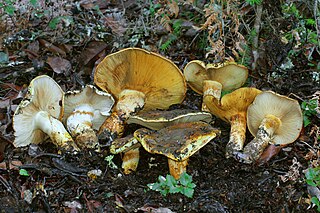
Phlegmacium ponderosum, also known as the Ponderous Cortinarius, is a species of mushroom producing fungus in the family Cortinariaceae. It is very large and due to its thick stem it can be mistaken for Boletus edulis.

Cortinarius caperatus is an edible mushroom of the genus Cortinarius found in northern regions of Europe and North America. It was known as Rozites caperata for many years before genetic studies revealed that it belonged to the genus Cortinarius. The fruit bodies appear in autumn in coniferous and beech woods as well as heathlands in late summer and autumn. The ochre-coloured cap is up to 10 cm (4 in) across and has a fibrous surface. The clay-colored gills are attached to the stipe under the cap, and the stipe is whitish with a whitish ring. The Latin specific name, caperatus, means wrinkled, and refers to the distinctive texture of the cap. The flesh has a mild smell and flavor.

Cortinarius mucosus, commonly known as the orange webcap or the slimy cortinarius, is a species of mushroom in the family Cortinariaceae. In North America, the species is more commonly associated with northern coniferous forests. The specific epithet is derived from the Latin word mucosus, meaning mucus.

Phlegmacium triumphans, also known as the birch webcap, or yellow girdled webcap is a basidiomycete mushroom in the family Cortinariaceae. It is found in Europe and regarded as edible by some authorities, although others call it suspect and it resembles inedible species.

Cortinarius rotundisporus, also known as the elegant blue webcap, is a basidiomycete mushroom of the genus Cortinarius found in southern Australia, where it is found in eucalypt forests and rainforests. The cap of the fruit body is a steely blue colour, with a yellowish boss, and paler similarly coloured stipe.

Cortinarius archeri is a species of mushroom in the genus Cortinarius native to Australia. The distinctive mushrooms have bright purple caps that glisten with slime, and appear in autumn in eucalypt forests.
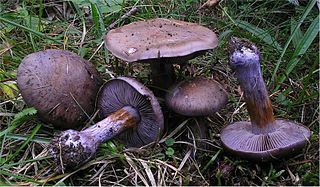
Thaxterogaster purpurascens is a species of mushroom producing fungus in the family Cortinariaceae. It is commonly known as the bruising webcap.

Cortinarius camphoratus, commonly known as the goatcheese webcap, is an agaric fungus in the family Cortinariaceae. The fungus is found in Europe and North America, where its fruit bodies (mushrooms) grow on the ground in a mycorrhizal association with spruce and firs in coniferous forests. Mushrooms are characterized by pale blue lilac colors when young, and a strong distinctive odor. Sources disagree as to the edibility of the mushroom, but they are generally not recommended for eating.
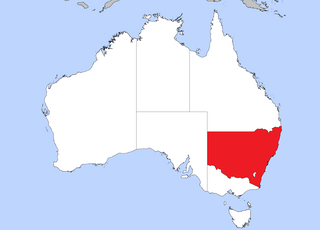
Phlegmacium basorapulum is a species of truffle-like fungus in the family Cortinariaceae. Found in New South Wales, Australia, the species was described as new to science in 2010.
Phlegmacium boreicyanites is a species of fungus in the family Cortinariaceae
Phlegmacium cremeiamarescens is a species of fungus in the family Cortinariaceae. It was originally described in 2014 by the mycologists Ilkka Kytövuori, Kare Liimatainen and Tuula Niskanen who classified it as Cortinarius cremeiamarescens. It was placed in the of the large mushroom genus Cortinarius. The specific epithet cremeiamarescens refers to the fruitbody colour and the bitter-tasting cap cuticle. Phlegmacium gentianeus is a sister species with which it has been previously confused. It is found in southern Europe and western North America, where it grows in coniferous forests.

Cortinarius erythraeus, sometimes known as the Jammie Dodger, is a basidiomycete fungus of the genus Cortinarius native to Australia.
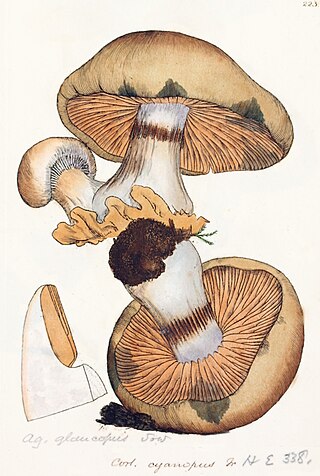
Phlegmacium glaucopus is a species of fungus in the family Cortinariaceae. It is commonly known as the blue-foot webcap.
Phlegmacium subfoetidum is a species of mushroom producing fungus in the family Cortinariaceae. It was previously known as Cortinarius subfoetidus.
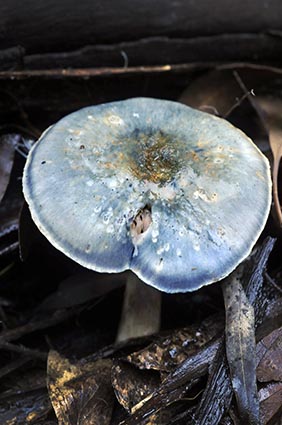
Cortinarius metallicus, originally described as Rozites metallica and commonly known as the steel blue rozites, is a species of mushroom native to Australia.

Cortinarius sublargus is a species of fungus in the family Cortinariaceae native to Australia. It was described in 1928 by John Burton Cleland from the Mount Lofty Ranges. Cleland also described Cortinarius radicatus in 1933 from material collected in Willunga Hill, Waitpinga, Mount Lofty, Mount Compass, and Kinchina, Though Cleland regarded them as distinct, later authorities determined them to be the same species. The latter name turned out to be a homonym, having already been given to a different species.

Thaxterogaster austrovaginatus is a species of ectomycorrhizal fungus in the famlily Cortinariaceae.
Austrocortinarius is a genus of fungi in the family Cortinariaceae.















